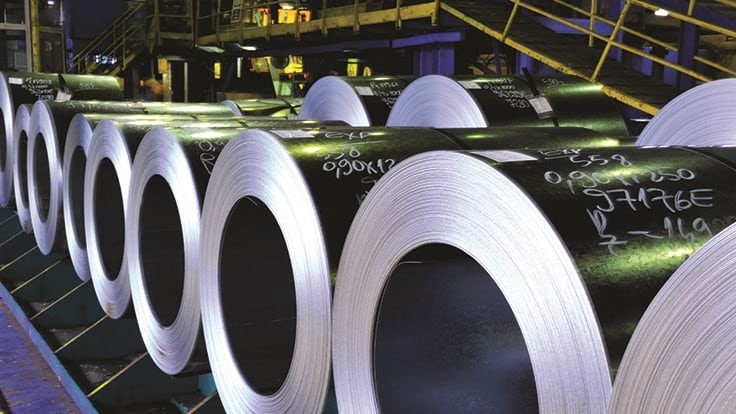Recyclingtoday | DeAnne Toto March 25, 2021
Economic Policy Institute report says overcapacity fueled by foreign government subsidies and other trade-distorting policies threatens additional harm to the U.S. steel industry if discontinued.

The American Iron and Steel Institute (AISI), Washington, has voiced its support for continuing the Section 232 steel tariffs that were introduced by the Trump administration in 2018, citing a new report from the Economic Policy Institute (EPI), “Why Global Steel Surpluses Warrant U.S. Section 232 Import Measures,” that addresses their effectiveness.
AISI says the report reaffirms that the steel tariffs have been effective in facilitating significant investments in new and upgraded mills, creating thousands of new jobs and protecting U.S. national security.
The report states that continued global steel overcapacity fueled by foreign government subsidies and other trade-distorting policies and practices threatens additional harm to the American steel industry if the tariffs are discontinued.
“This study makes it abundantly clear that the steel tariffs are working,” Kevin Dempsey, president and CEO of AISI, says. “We commend the economic analysis conducted by EPI which confirms that, due largely to the Section 232 steel tariffs, the American steel industry has been able to invest nearly $16 billion to build, upgrade or expand steel facilities while also enabling the industry to effectively restructure. While these investments have created 3,200 new jobs, the tariffs kept many more workers on the job as the industry was threatened by significant challenges from foreign government trade-distorting policies and practices that have created substantial steel overcapacity worldwide. We are pleased that the report also recognizes that those challenges still exist and that keeping the steel tariffs in place is critical until a permanent solution to the chronic problem of excess global steel production capacity is achieved. We urge that opinion leaders, policymakers and steel partners all across the U.S. take a look at this important new report and work to ensure that steel tariffs remain in place.”
The executive summary of the EPI report states, “For decades, chronic global steel supply gluts have undermined the U.S. steel industry with surging imports to U.S. markets undercutting prices, domestic production, employment and investments. This oversupply jeopardizes the fundamental health of the U.S. steel industry—one of the cleanest and most energy-efficient steel industries globally.
“Global steel surpluses are the result of chronic global excess steelmaking capacity in major exporting countries, including China, India, Brazil, Korea, Turkey, the EU and other nations, much of it from state-owned and state-supported enterprises that are heavy polluters,” according to the ERI.
The report concludes:
- The U.S. steel industry is a vital component of the American economy, supported nearly 2 million jobs that paid, on average, 27 percent more than the median earnings for men and 58 percent more than the median for women in 2017, prior to the tariffs.
- Global steel markets are plagued by chronic excess capacity, with theOrganisation for Economic Co-operation and Development (OECD) calculating that this excess capacity is 5.8 times the productive capacity of the entire U.S. steel industry.
- The economic picture for U.S. steel producers brightened considerably beginning in 2018 until the pandemic began. In particular, U.S. steel producers announced plans to invest more than $15.7 billion in new or upgraded steel facilities, creating at least 3,200 direct new jobs, many of which are now poised to come online. Additionally, more than $5.9 billion were invested by nine firms in plant acquisitions as part of industry restructuring to increase efficiency.
- Administrations dating back to the mid-20th century have worked to mitigate the effects on U.S. steel producers of unfair global practices. In this context, the recent Section 232 import measures continue a long thread of executive policy actions to relieve damages to U.S. producers by unfair competition and global surplus capacity in steel.
- China has massively and rapidly expanded its steel production capacity using subsidies and other forms of distortionary government support to expand steel capacity by 418 percent, or 930 million metric tons (MMT), since 2000.
- Countries across several continents followed in China’s footsteps, developing more excess capacity. Other major steel-producing countries achieving rapid capacity growth between 2000 and 2019 include India, Turkey, Iran, South Korea, Vietnam, Russia, Brazil, Mexico and Taiwan, with increases ranging from 8 MMT in Taiwan to 95 MMT in India.
- Rapid expansion elsewhere comes with falling domestic production astotal U.S. steel production capacity fell by 5.5 MMT to 110 MMT in 2019, with world market share shrinking to less than 5 percent in 2019 from 10 percent in 2000.
- Section 232 measures delivered near-immediate benefits, helping tocurb U.S. steel imports by 27 percent by 2019. Import penetration of the U.S. market fell to 26 percent of all steel consumed in the United States in 2019 from 35 percent in 2017.
- Section 232 measures have had no meaningful real-world impact on the prices of steel-consuming products (such as motor vehicles), according to econometric analysis.
- Widespread exclusions to Section 232 measures mitigate positive economic impacts. Nearly 108,000 product-specific exclusions have been granted through July 2020 alone in addition to broad, countrywide tariff exemptions for roughly one-third of all imports.
- Jobs, national security and the steel industry itself are at risk if Section 232 measures are discontinued or weakened in the postpandemic economy. The diminished global economic outlook as the world emerges from the COVID-19 pandemic means that the brief reprieve from a global supply glut and nascent recovery enjoyed by U.S. steelmakers is likely to evaporate.
- Relaxing or reversing Section 232 measures also would provide an advantage for low-priced, high carbon-polluting producers overseas.
- A permanent global solution is the best answer. The Biden-Harris administration should press for a permanent multilateral solution to the chronic problem of excess global steel production capacity.
